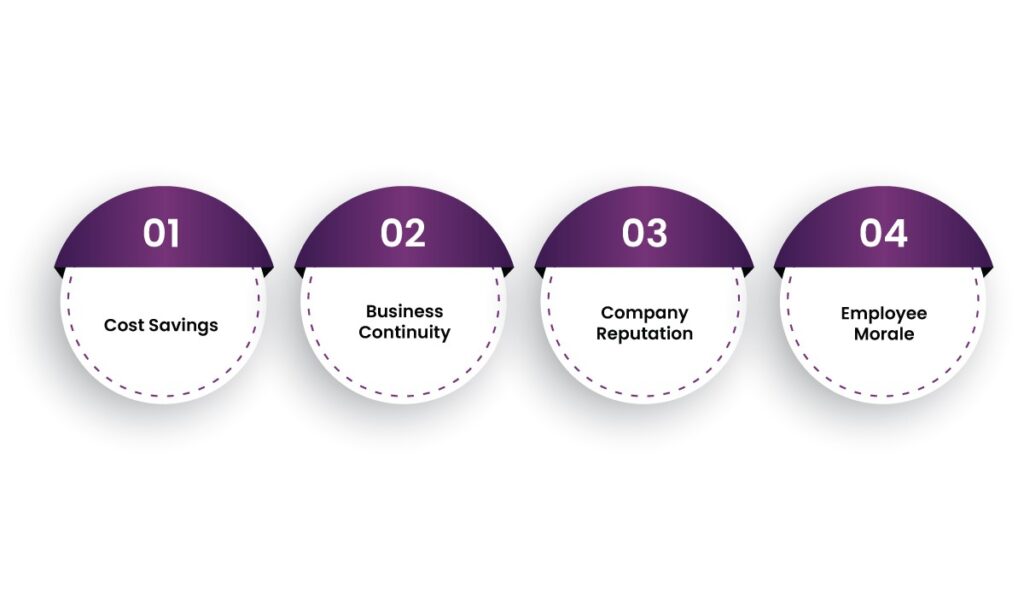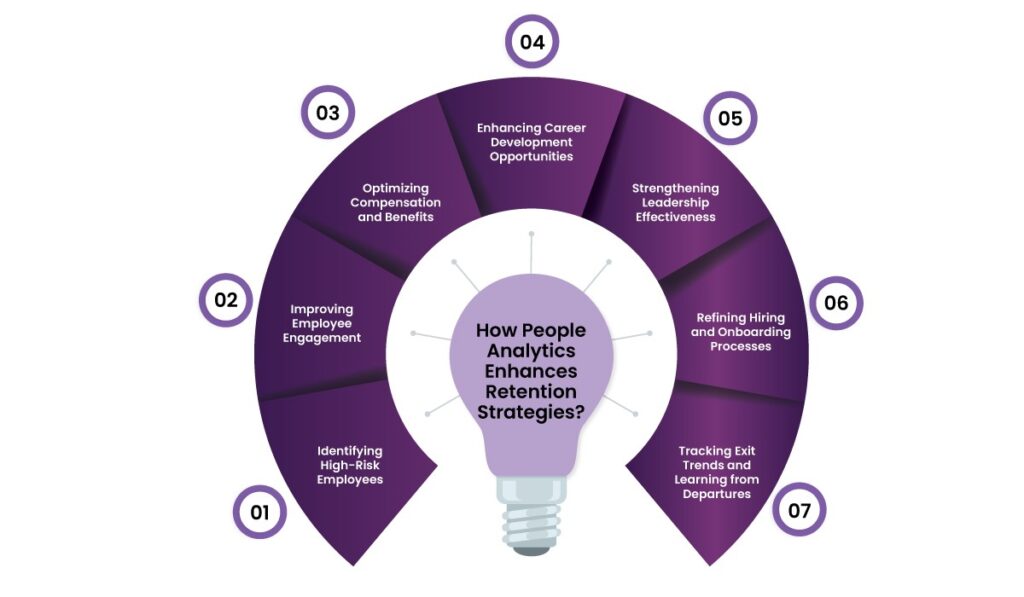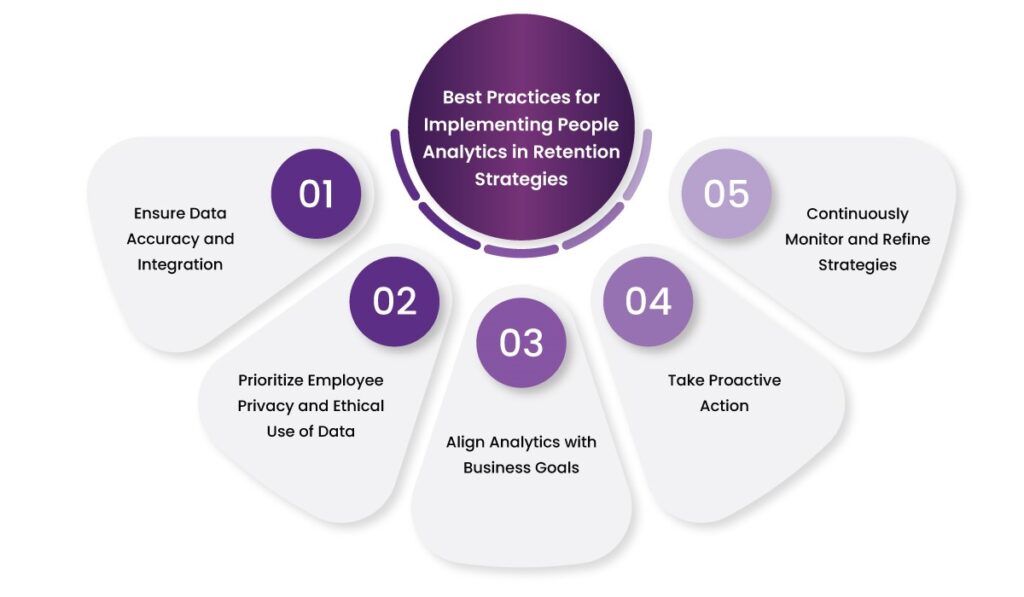Employee turnover is both costly and disruptive. Retaining top talent is no longer just about offering competitive salaries—it requires understanding employee needs, predicting attrition, and proactively enhancing job satisfaction. Organizations that leverage people analytics gain a strategic advantage by using data-driven insights to refine their retention strategies.
People analytics enables businesses to understand why employees leave, identify engagement trends, and implement targeted strategies to enhance retention. By combining HR data with predictive models, organizations can foster a workplace where employees feel valued, engaged, and motivated to stay.
So, how can companies harness the power of people analytics to strengthen their employee retention strategies? Let’s explore its critical role in shaping modern workforce management.
Table of Contents
Why Is Employee Retention Important?
High employee turnover can have serious consequences for a business, impacting financial stability, productivity, and workplace morale. When organizations fail to retain top talent, they not only face higher costs but also risk disrupting operations and damaging their reputation. Here’s why employee retention should be a top priority:
- Cost Savings: The expense of replacing an employee extends beyond recruitment costs. It includes onboarding, training, lost productivity, and knowledge gaps. Studies show that replacing an employee can cost up to twice their annual salary, making retention a financially sound strategy.
- Business Continuity: Frequent turnover creates operational inefficiencies, causing workflow disruptions that affect project timelines, service delivery, and customer satisfaction. Retaining employees ensures stability and consistency in business operations.
- Company Reputation: High turnover rates can deter both potential candidates and clients. A company struggling with retention may be perceived as having poor management, a weak work culture, or a lack of career growth opportunities—all of which make it difficult to attract and retain top talent.
- Employee Morale: A revolving door of employees can negatively impact team cohesion. When employees constantly see their colleagues leaving, it reduces team spirit, engagement, and workplace satisfaction, leading to lower productivity and motivation.

Organizations that invest in proactive retention strategies foster loyalty, improve job satisfaction, and drive long-term business growth. By prioritizing employee well-being, career development, and a positive work culture, businesses can create an environment where employees feel valued, engaged, and motivated to stay.
How People Analytics Enhances Retention Strategies?
People analytics transforms employee retention efforts by providing actionable insights based on workforce data. By leveraging these insights, organizations can develop proactive strategies that improve engagement, optimize compensation, and enhance career growth opportunities. Let’s explore some key ways people analytics optimizes employee retention.
1. Identifying High-Risk Employees
Using historical HR data, people analytics can predict which employees are at risk of leaving by analyzing trends in absenteeism, declining productivity, lack of engagement, and other red flags. By identifying high-risk employees early, HR teams can intervene with personalized strategies to address concerns before they lead to resignations.
For example, Synergy Comprehensive Reporting feature helps businesses track workforce trends, giving managers real-time visibility into employee sentiment and retention risks. This allows organizations to proactively address concerns and improve retention rates.
2. Improving Employee Engagement
Employee engagement is a key driver of retention. People analytics tools analyze feedback from employee surveys, pulse checks, and performance reviews to measure engagement levels. With these insights, HR teams can tailor engagement initiatives, such as career development programs, mentorship opportunities, or flexible work arrangements, to create a more motivating and fulfilling workplace.
By identifying factors affecting engagement, organizations can implement data-driven strategies that help employees feel valued and connected to the company’s mission.
3. Optimizing Compensation and Benefits
While a competitive salary is essential, it isn’t always enough to retain employees long-term. People analytics provides insights into compensation trends within the company and industry benchmarks, helping HR leaders design attractive and fair pay structures that align with employee expectations.
Additionally, analytics can highlight gaps in benefits, such as healthcare, parental leave, or remote work flexibility, that might impact retention. Synergy’s Payroll Management feature automates salary processing and compliance, ensuring that employees are fairly and accurately compensated.
By using real-time compensation analytics, organizations can make informed decisions to enhance employee satisfaction and loyalty.
4. Enhancing Career Development Opportunities
A lack of career growth opportunities is a major reason why employees leave. People analytics helps organizations identify skills gaps and recommend tailored training programs that align with employee aspirations and business needs.
HR teams can analyze learning and development trends to determine which training programs lead to better retention and job satisfaction. Synergy’s Task Management and Performance Tracking tools provide real-time insights into employee growth, making career progression transparent and encouraging employees to stay and grow within the organization.
When employees see a clear path for advancement, they are more likely to remain engaged and committed to the company’s long-term vision.
5. Strengthening Leadership Effectiveness
Leadership plays a crucial role in employee retention. People analytics assesses leadership styles, manager effectiveness, and team satisfaction levels to identify areas for improvement. By evaluating manager-employee interactions, businesses can provide leadership training and coaching to enhance managerial effectiveness and create a more supportive work environment.
Synergy’s Peer Connect feature fosters better communication between employees and leaders, ensuring transparency, collaboration, and stronger workplace relationships.
With data-backed leadership insights, organizations can empower managers to become effective mentors and motivators, ultimately improving retention.
6. Refining Hiring and Onboarding Processes
Retention begins at recruitment. People analytics helps HR teams refine hiring processes by identifying traits and experiences that contribute to long-term employee success. Predictive analytics can match candidates with roles where they are most likely to thrive, reducing early attrition rates.
Through Geofencing and Compliance Tools, Synergy ensures seamless onboarding, helping HR teams track remote or field employees efficiently while providing new hires with a smooth transition into the organization.
A well-structured onboarding process leads to higher engagement and lower turnover, setting employees up for long-term success.
7. Tracking Exit Trends and Learning from Departures
Every resignation provides valuable insights. By analyzing exit interviews and turnover data, HR teams can identify patterns and recurring issues driving attrition. Companies can then implement changes based on this data to improve retention and workplace satisfaction.
For example, if an organization notices a trend in employees leaving due to poor work-life balance, it can introduce flexible schedules, remote work policies, or hybrid work models to mitigate future turnover.
By using data-driven exit analysis, businesses can make strategic improvements to ensure a more engaging and fulfilling work environment.

Best Practices for Implementing People Analytics in Retention Strategies
To maximize the effectiveness of people analytics, businesses must follow structured approaches that ensure data accuracy, ethical usage, and continuous improvement. Here are some best practices to successfully implement people analytics in employee retention strategies.
1. Ensure Data Accuracy and Integration
For people analytics to provide meaningful insights, organizations must collect, store, and integrate data from multiple HR sources, including attendance records, payroll systems, employee surveys, and performance management tools.
Without accurate and centralized data, retention strategies may be based on incomplete or misleading information. Synergy’s Comprehensive HR and Payroll Management system enables businesses to maintain a single source of truth, ensuring that HR teams access real-time, reliable insights to make informed decisions.
2. Prioritize Employee Privacy and Ethical Use of Data
While people analytics is a powerful tool, companies must handle employee data responsibly. Transparency in how data is collected, stored, and used builds employee trust and fosters a positive workplace culture.
HR teams should clearly communicate their data privacy policies and implement secure storage measures to protect sensitive employee information. Ethical people analytics not only enhances retention strategies but also strengthens employer-employee relationships.
3. Align Analytics with Business Goals
People analytics should not operate in isolation—it must support broader business objectives such as boosting employee engagement, reducing turnover, and improving workforce productivity.
HR teams should analyze data strategically to ensure that insights drive meaningful improvements in workforce management. When analytics aligns with organizational goals, retention strategies become more effective and actionable.
4. Take Proactive Action
Access to data alone is not enough—businesses must act on insights immediately. If analytics highlight declining engagement levels, HR should introduce targeted initiatives such as mentorship programs, employee recognition schemes, or improved work-life balance policies.
Similarly, if turnover trends indicate leadership concerns, organizations should prioritize leadership training and development to foster a supportive work environment. Proactive decision-making based on data leads to long-term retention success.
5. Continuously Monitor and Refine Strategies
Workforce dynamics change over time, and retention strategies must evolve accordingly. HR teams should regularly assess key metrics like turnover rates, employee engagement levels, and job satisfaction trends to fine-tune their approach.
By adapting strategies based on ongoing data analysis, businesses can ensure that their retention efforts remain effective, relevant, and future proof in an ever-changing work environment.

Final words
People analytics is a game-changer in employee retention. By leveraging data-driven insights, businesses can proactively address workforce challenges, enhance engagement, and optimize retention strategies. From predicting turnover risks to refining leadership effectiveness, people analytics provides clarity and actionable intelligence for informed decision-making.
With Synergy HRMS and People Analytics Tools, businesses can seamlessly track workforce trends, automate HR functions, and foster long-term employee satisfaction. Investing in the right technology and data-driven strategies today will lead to a stronger, more engaged workforce tomorrow.
Ready to transform your retention strategies? Explore Synergy advanced people analytics features and start making data-driven HR decisions today!
FAQs
1. What is people analytics in HR?
People analytics in HR refers to using data and insights to improve workforce management, employee engagement, and retention strategies.
2. How does people analytics help with employee retention?
It identifies turnover risks, engagement trends, and areas of improvement, enabling businesses to take proactive steps to retain employees.
3. What key metrics should HR track for retention strategies?
Metrics like turnover rates, engagement scores, exit trends, and performance data help HR teams refine retention efforts.
4. How can companies use people analytics to improve manager effectiveness?
By analyzing leadership feedback, engagement surveys, and performance evaluations, businesses can train managers to enhance employee satisfaction.
5. What role does predictive analytics play in retention?
Predictive analytics forecasts which employees are at risk of leaving, allowing HR teams to intervene early.














